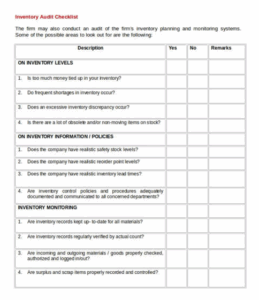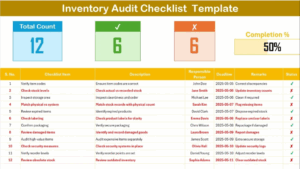Inventory accuracy is more than just knowing what’s on your shelves. Too much stock can tie up valuable capital and may even increase storage costs. Too little, and you risk stockouts that delay orders, which will frustrate customers and harm your reputation.
If you’re struggling with stock discrepancies or fulfillment delays, an inventory audit is your first line of defense.
For eCommerce businesses, especially those scaling across multiple warehouses, a clear and repeatable inventory audit checklist ensures accuracy and improves efficiency at every turn.
What is an Inventory Audit Checklist?
An inventory audit checklist is a structured document that standardizes procedures for reviewing stock levels and validating inventory records. It outlines every step needed to verify physical inventory against digital records, such as what’s stored in a warehouse management system like ShipHero.
If you want to learn how to audit your warehouse, this checklist provides consistency, accountability, and a streamlined flow from receiving inventory to reconciliation.
Common Checklist Formats
- Simple Spreadsheet: Great for Shopify sellers or single-location operations. Fields typically include SKU, expected quantity, physical count, and variance notes.
- Detailed Audit Form: Often integrated directly into ShipHero, these forms log audit date, staff involved, discrepancies, and warehouse location. Ideal for multi-warehouse operators who require more in-depth insights.
- Cycle Count Sheets: Part of a rotating schedule. These checklists break audits into smaller, manageable batches, such as electronics this week and apparel next.
If you’re building your own warehouse audit checklist, start by deciding which format suits your audit cadence, staff size, and inventory complexity.
Examples of an Inventory Audit Checklist Template

Simple Inventory Audit Checklist
This checklist uses a basic yes/no format to evaluate the general health of inventory across three sections: inventory levels, policies, and monitoring. It’s quick to complete and ideal for identifying broad issues, such as shortages or outdated stock.

Detailed Inventory Audit Checklist
This version includes specific checklist items, responsible personnel, deadlines, remarks, and status updates. This offers more visibility and control. It tracks task progress, assigns accountability, and helps teams follow through on corrections.
What Should You Include in an Inventory Audit Checklist?
The effectiveness of any inventory audit hinges on what you track. A well-structured inventory audit checklist builds clarity into every step of your stock review process. Including the right fields uncovers discrepancies faster and supports consistent performance across every audit cycle.
Here’s a list of what to include:
- Date of the Audit: Keeps records organized and measures performance over time.
- Number of People Involved in Inventory Audit: Ensures accountability by documenting who counted what.
- Date of Last Inventory Audit: Prevents duplicated work and identifies any long gaps between reviews.
- Status of Inventory Stocks: Notes whether products are overstocked, understocked, or aligned; this helps optimize resource allocation.
- Status of the Inventory Audit Plan: Marks whether the audit is pending, active, or completed; keeps the team aligned with audit timelines.
- History of Issues Related to the Inventory: Reveals recurring discrepancies or damages, helping teams identify discrepancies proactively.
- Competency of Inventory Staff: This evaluates audit skills per team member, which helps identify training needs and optimize team assignments.
- Condition of Receipts: Verifies that receipts are legible and complete to validate data integrity and support accurate reconciliation.
Important Inventory Audit Procedures
A robust audit strategy uses multiple methods. Each one adds a layer of verification, giving you the best chance to identify discrepancies, confirm stock accuracy, and audit systematically.
ACB Analysis (Activity-Cost-Baseline)
ACB analysis identifies cost drivers (e.g., storage, handling) in inventory by mapping the impact of each inventory activity on the budget. This helps you identify areas where you’re overspending and find ways to reduce costs without compromising quality.
Trend and Ratio Analysis
This uses ratio checks (e.g., sales-to-stock ratios) and trend reviews (e.g., seasonal stock fluctuations) to quickly identify anomalies or potential fraud. This assesses inventory levels based on performance and reveals deeper insights into shrinkage or miscounts.
Physical Inventory Count
A physical inventory count is exactly what it sounds like. Your team goes through your warehouse item by item, scanning barcodes or manually tallying products, and then compares these real-world counts to your digital records.
Cut-Off Analysis
This procedure examines stock transactions around period-end (e.g., the end of the month) to confirm that all purchases and sales are recorded in the correct period. This verifies compliance with accounting standards and avoids overstatement or understatement.
Cycle Count
Instead of a single annual audit, a cycle count breaks audits into daily or weekly rotations by product category, keeping records more accurate throughout the year. This method is ideal for companies using ShipHero’s warehouse receiving process checklist to avoid full shutdowns.
Product Reconciliation
Compare the numbers: system records vs. physical stock. Investigate any mismatches and specify the reasons to update the documentation accurately.
Freight Cost Analysis
Examine if freight costs align with inventory valuation. Spot inconsistencies that could point to vendor overbilling or recordkeeping errors.
Overhead Analysis
Distribute warehouse costs (utilities, rent, labor) to inventory items. This reveals the full carrying costs, supports more accurate pricing and replenishment decisions.
Streamline Your Inventory Audits with ShipHero’s Automated Inventory Management System
ShipHero’s Automated Inventory Management System simplifies inventory audits by providing real-time data and seamless tracking of stock levels. With advanced features like cycle counting, barcode scanning, and automated reconciliation, ShipHero ensures accuracy and reduces manual errors.
The system generates real-time audit reports, making it easy to identify discrepancies and maintain inventory accuracy. By automating these processes, ShipHero streamlines your inventory audits, saving time and improving efficiency across your warehouse operations.
Key Takeaways
- An inventory audit checklist standardizes stock reviews by outlining every step needed to verify physical inventory against digital records.
- Including detailed fields (e.g., audit date, stock status) effectively tracks changes over time, drives accountability, and supports data-driven decisions.
- Combining methods like cycle counts and physical counts enhances accuracy and keeps inventory aligned with real-world conditions.
Frequently Asked Questions
What Happens If You Fail an Inventory Audit?
Failing an inventory audit can lead to financial losses due to undetected shrinkage, stockouts, or overstocking scenarios. It may even create compliance issues if financial statements or regulatory submissions rely on inaccurate information.
Who Manages the Inventory Audit Checklist?
Inventory managers, warehouse leads, or internal auditors typically oversee the checklist. Their role is to ensure the process is followed, issues are documented, and outcomes are reviewed.
Are Inventory Audit Checklists Required for Businesses?
They aren’t always legally required, but are considered best practice. They are critical for maintaining operational control and financial accuracy.